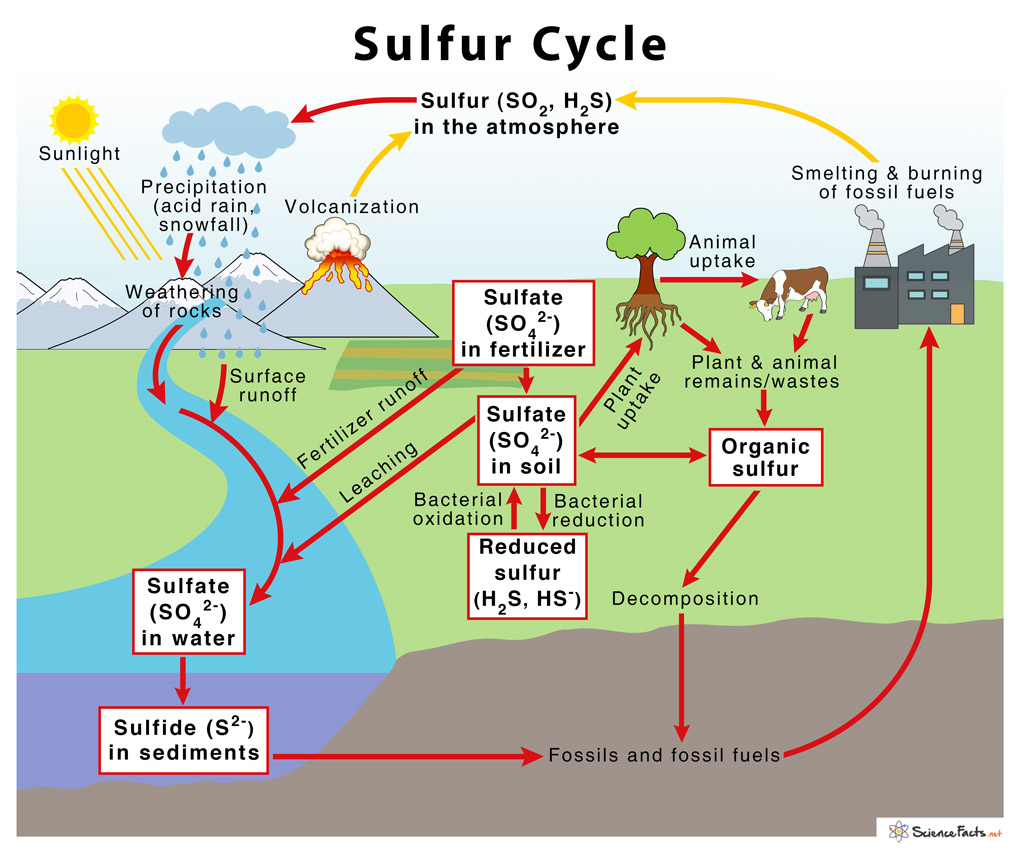Sulfur Cycle
What is the sulfur cycle?
The biogeochemical cycle showing the collection of processes by which sulfur moves in its different forms between the terrestrial, aquatic and living systems on earth

What are the Different Steps of the Sulfur Cycle?
1) Formation of Inorganic Sulfur
It occurs through two different processes –
- Biological – By decomposers present in the soil
- Geological – Through weathering of rocks formed from geological uplift
2) Oxidation of Inorganic Sulfur to Sulfate (SO42−)
It involves two steps –
- Hydrogen sulfide is oxidized to produce elemental sulfur by certain photosynthetic bacteria such as Chlorobiaceae and Chromatiaceae species
- Elemental sulfur is then converted to sulfate by chemolithotrophic bacteria
3) Assimilative Reduction of Sulfate to Sulfide (S2−)
Also known as sulfur reduction, it is performed by plants, fungi and various microorganisms such as Desulfovibrio and Desulfobulbus species in two steps –
- Sulfates are converted to sulfites
- Reduction of sulfites to hydrogen sulfides
4) Incorporation of Sulfide into Organic Compounds
The sulfide assimilated is converted into an organic form which the animals consume and fix through the foods they eat. Once these plants and animals die, decomposers release the fixed organic sulfur back into its free form as elemental sulfur.
What is the importance of the sulfur cycle to living organisms?
- Forming an essential component of all kinds of proteins and some vitamins and hormones in living organisms
- Producing fossil fuels such as coal, petroleum and natural gas
- Contributing to a majority of metal deposits because of its ability to act as an oxidizing as well as reducing agent
- Serving as the source of energy to the sulfur-reducing bacteria present in the hydrothermal vents
- Reducing global warming caused by the greenhouse gases by absorbing the ultraviolet radiation of the sun
- Helping in the growth of plants, the primary producers of the ecosystem
How do humans affect the Sulfur Cycle?
Human intervention release excess sulfur into the environment, thus disturbing the sulfur cycle in the following ways –
- Releasing sulfur from oil and coal-based power plants
- Processing of sulfur-containing metals
- Using sulfur-containing fertilizers
The sulfur emitted through all the above human activities reacts with water, oxygen, and other chemicals in the atmosphere and precipitates down in the form of rain, known as acid rain that reduces agricultural yield, affects marine life, and damages buildings and monuments
Article was last reviewed on Friday, February 12, 2021





